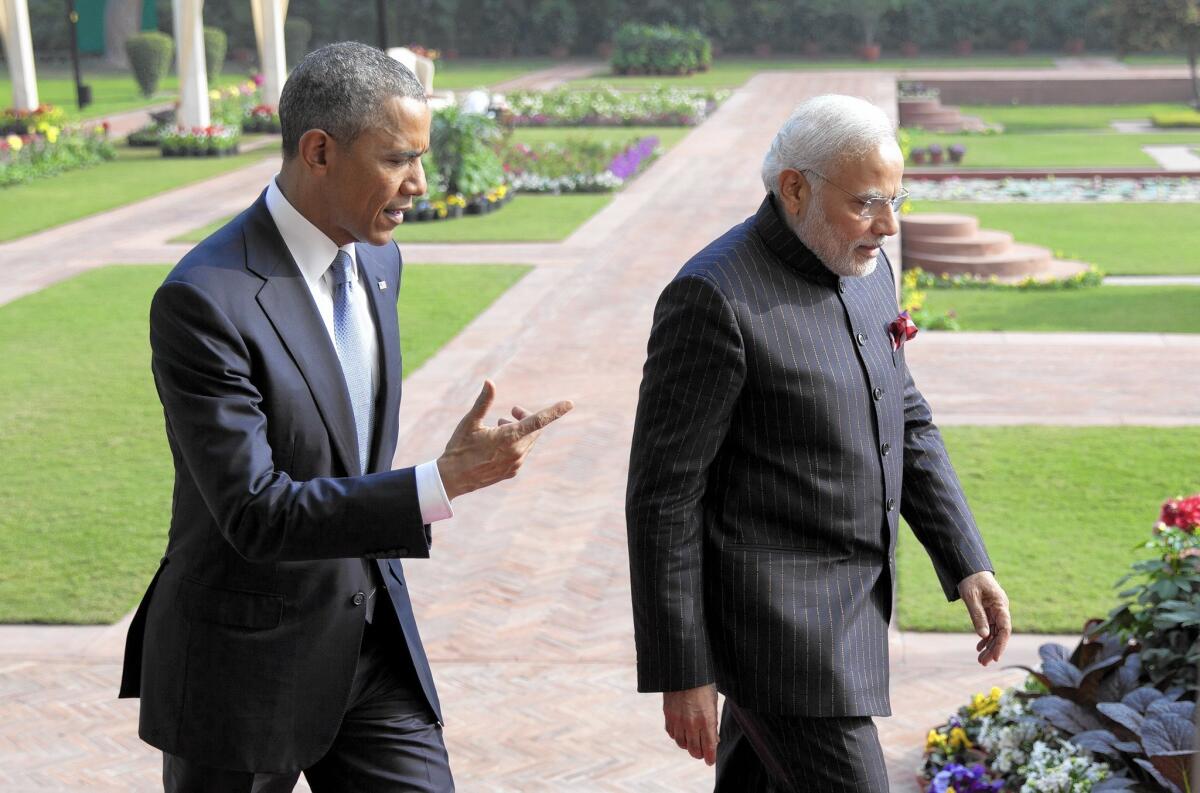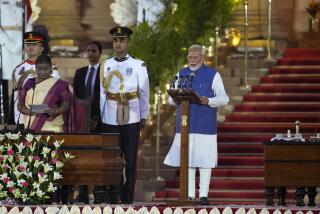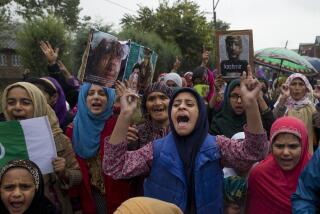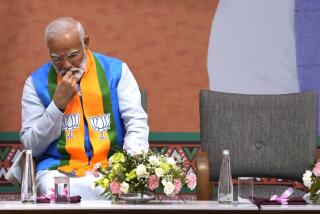Indian premier finds a partnership with U.S. suits him

- Share via
Reporting from New Delhi — The suit said it all. As global fashion mavens know by now, when Prime Minister Narendra Modi met President Obama in New Delhi this week, the broad-chested 64-year-old Indian leader wore a navy blue suit with his name stitched into the wool over and over in gold pinstripes.
Indians called it either swaggeringly stylish or the height of vanity. But regardless, the suit seemed to herald the arrival of a muscular new leader on the world stage.
By brushing aside years of obstacles to strike wide-ranging deals with the United States — and an unlikely rapport with Obama — Modi signaled a fundamental change in an Indian foreign policy long criticized for being timid, inflexible and punching below its weight.
Analysts say a closer partnership with the U.S. could help revive India’s economic growth and give it more leverage in dealing with China, the defining rivalry of this century in Asia. And by voicing support for a global treaty to combat climate change — while not committing to making difficult emissions cuts — Modi struck a delicate balance on an issue on which India risked becoming a global outlier.
“It’s a level of confidence we haven’t seen in some time” from an Indian prime minister, said Alyssa Ayres, a former senior State Department official for South Asia who is now senior fellow at the Council on Foreign Relations.
“The last time there was somebody with this level of global ambition and this level of activity internationally was Nehru, who really helped define a global agenda for India,” Ayres said, referring to India’s iconic first prime minister, Jawaharlal Nehru.
Unlike Nehru’s policy of nonalignment — which attempted during his 16 years in power to keep newly independent India on the sidelines of the Cold War, alienating it for decades from the United States — Modi in eight months in office has sought common ground with various world leaders, often courting them personally.
On Twitter he heaped lavish praise on his Japanese counterpart, Shinzo Abe, gushing in a birthday message that “I cannot but marvel at his insight and expertise.” (The feeling seems mutual for Abe, who follows only four people on Twitter, one of whom is Modi.)
In November, Modi held warm talks with Australian Prime Minister Tony Abbott, pausing to click a selfie of the two of them while inking a series of security and nuclear agreements.
Even Modi’s first meeting with Chinese President Xi Jinping was seen as a success, with Modi hosting the Chinese leader and his wife in his home state of Gujarat, and expressing more willingness to cooperate with Beijing on economic issues.
While the personal focus has its detractors — “India is known for our soft power, but this is just too soft, too gooey-gooey,” said Madhu Kishwar, a prominent writer and professor — analysts say Modi has signaled that India is ready to be a major player.
His predecessor, Manmohan Singh, a brilliant but painfully quiet economist, reached out to the United States to sign a landmark civilian nuclear pact in 2005. But the deal stalled as India’s economy faltered, Singh was edged out within his own party and U.S. officials seemed to lose interest in the relationship.
Perhaps the most important development in Obama’s three-day visit was a broad agreement to move forward the deal on civilian nuclear power, with commitments from both countries to resolve nettlesome disputes over legal liability and tracking of atomic material.
While the details remained vague, both sides called the deal a breakthrough. That surprised many who thought Obama’s trip — centered on India’s annual Republic Day parade — would be largely ceremonial.
“By combining strong political will with a laser-like focus on practical solutions, Modi has altered the narrative on India’s relationship with America,” political analyst C. Raja Mohan wrote Thursday in the Indian Express.
Modi, who served for a decade as chief executive of Gujarat, is known as a disciplined, teetotaling workaholic who avoids New Delhi’s social circuit and boasts about how little sleep he gets. A devout Hindu, he worked as a young man for a fundamentalist Hindu social organization closely tied to the Bharatiya Janata Party, the right-wing party he led to a landslide election victory last May.
Modi has few apparent confidants, and he so disdains direct interaction with the press that the White House was unsure whether he would agree to a side-by-side news conference with Obama in New Delhi — which he did, with each leader taking one question.
These are not the qualities of a natural politician, yet Modi has deployed the personal touch strategically, particularly to disarm those who have opposed him.
He invited the Bollywood actor Aamir Khan — who had criticized him over communal riots in Gujarat in 2002 that killed hundreds, mainly Muslims — to meet him at his official residence last year. Afterward Khan was quoted as saying that Modi “talked of benefiting people, especially the poor, and bringing happiness to their lives.”
Modi’s greatest turnaround has been with the United States, which denied him a visa a decade ago after an outcry among American Muslims and human rights groups over the riots. Although he has never been implicated in the violence, Modi only recently expressed remorse over the deaths, likening them, controversially, to a car running over a puppy.
Few believe he and Obama would have an easy bond, but analysts say both have an interest in building a relationship.
“They’re as different as chalk and cheese,” said Ashok Malik, a columnist who has advised Modi. “But history brings people together at various points with strange results. Obama is looking at some sort of foreign policy legacy after what has been a very challenging term. For Modi, rebuilding India would be his legacy, and he needs not just Obama but America to fulfill his mandate for growth.”
On domestic policy, Modi has been similarly brash. He was criticized last month for bypassing Parliament and issuing a series of ordinances, or temporary laws, including one that eases the way for companies to buy land for industrial projects.
If India’s economy doesn’t pick up, his leadership style will be judged a failure. Yet for now Modi is basking comfortably in the afterglow of Obama’s trip.
“I think it was a great visit,” said Kanchan Gupta, a pro-Modi columnist. “In fact, every diplomat dreams of a visit like this but few actually turn out like this.”
Twitter: @SBengali
More to Read
Sign up for Essential California
The most important California stories and recommendations in your inbox every morning.
You may occasionally receive promotional content from the Los Angeles Times.











